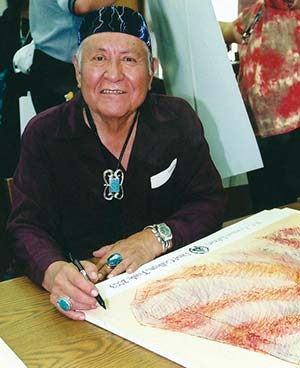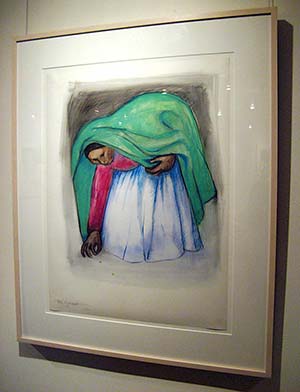National museum spotlights early R.C. Gorman
By Noel Lyn Smith
Navajo Times
WASHINGTON, March 5, 2011


ABOVE: R.C. Gorman signs commemorative posters he created for the dedication of the R.C. Gorman Library Dec. 31, 2003, at DinŽ College in Tsaile, Ariz. (Courtesy photo - Ed McCombs/Diné College)
BELOW: "The Green Shawl," by R.C. Gorman, is an oil pastel and wash on paper and was made in 1969. It is one of 28 images from the renowned artist now on display in the "R.C. Gorman: Early Prints and Drawings, 1966-1974" exhibition at the National Museum of the American Indian in Washington, D.C. (Times photo - Noel Lyn Smith)
When Elizabeth Hupert visited the National Museum of the American Indian the last thing she expected to find is an exhibit on Navajo artist R.C. Gorman.
As Hupert made her way through the museum's Sealaska Gallery, she paused and studied each image.
"I like how simplistic it is," she said. "I like the fact that he uses women in his portraits."
"R.C. Gorman: Early Prints and Drawings, 1966-1974" is an exhibit of 28 drawings and lithographs that show Gorman's beginnings as an artist who became world famous.
Hupert, of Charlottesville, Va., first noticed Gorman's work 15 years ago and has been a fan ever since.
Her favorite piece in the collection is "The Green Shawl," a 1969 oil pastel and wash on paper that depicts a Native woman in a vibrantly colored shawl bending down.
Kathleen Ash-Milby, Navajo, an associate curator at the NMAI's George Gustav Heye Center in New York City organized the Gorman exhibit. It showed in 2006 at the Heye Center and she is pleased that it has been revived and put on display in Washington.
Gorman is renowned for his iconic imagery of Navajo women.
Born Rudolph Carl Gorman in 1931 in Chinle, he was the son of the late artist and Navajo Code Talker Carl Gorman and Adelle Katherine Brown.
After attending college in Arizona and serving in the Navy, Gorman studied for a year at Mexico City College where he was influenced by such pioneers of monumental realism as painters and muralists Diego Rivera and José Clemente Orozco.
He returned to Mexico in the early 1960s to learn printmaking and produced some of his early work under the tutelage of print master José Sanchez.
Among the work created from that period is "Navajo Mother in Supplication" (1966), a lithograph on paper that shows a mother cradling her child.
At the entry to the hall is a rare self-portrait from 1973 that shows a longhaired and mustachioed Gorman sporting a headband and sunglasses.

